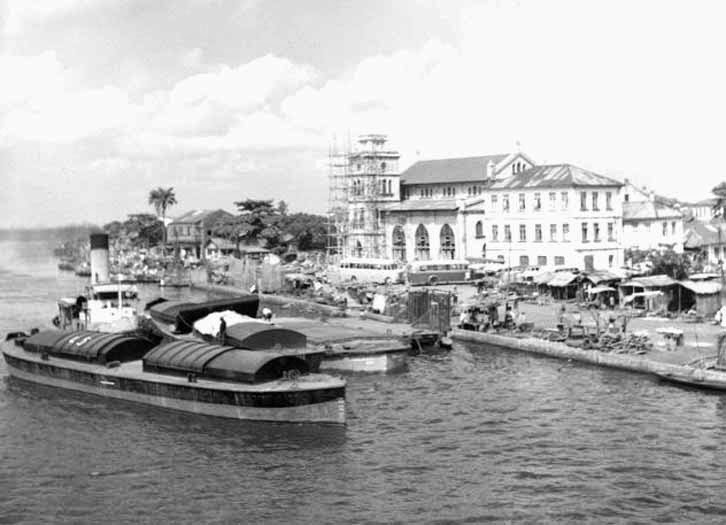By Tajudeen Sowole
Six decades of architecture photography across Lagos Island
by Gillian Hopwood, currently showing as A Photographer’s Odyssey, at
Wheatbaker Hotel, Ikoyi, and ending on April 9, 2015 tells the story of a city
with inherent multi-culture architectural texture.
Hopwood, an architect
has been living in Nigeria with her husband, John Godwin, a professor of
architecture, since 1954 when they both arrived here from England. Supported by
Wheatbaker.and
Vineyard, the opening of exhibition of Hopwood's photography works was also
accompanied with the launch of a book, A Photographer's Odyssey, which
she co-authored with Godwin.
 |
| Ebute Ero Wharf (1954), by Gillian Hopwood |
From the Gothic to
Portuguese and mixed of modern as well as contemporary designs, which
characterise Lagos Island landscape, Hopwood's lens documents generations of
architectural tastes that make the city's enigmatic trajectory. Taking shots of
buildings and streetscape during "every Sunday walk" in 1954 was an
extension of documenting her journey - as an expatriate- in Lagos, Hopwood tells his guest, few days
after the exhibition opened. But many decades after, in 2004 precisely, a
comparative idea, she discloses, came into the documentary concept "Comparative architecture on how Lagos
has changed over the decades."
Some of the display
include photographs of streetscapes such as Adeniji Adele Road, a foreshore for
canoes trading on the lagoon; Upper King Road, named after Dr King; Balogun
Square, a large stretch with shops on the ground floor and residence on upper
levels; Moloney Street with the famous building that was "first a branch
of John Holt, then a noisy night club" and some years ago a shopping Mall;
and Onikan Road, described as the then only access way to Ikoyi. Also on
display are pictures of memorable or landmark buildings such as Iga Idunganran
Entrance to the Oba of Lagos Palace said to have been originally built as
Portuguese design, but changed over the decades; abandoned restoration project,
Ilojo Bar at Tinubu Square, but still standing with Brazilian architecture; the
Central Legislative House, at the perimeter of Tafawa Balewa Square (TBS); and
the Central Mosque on Victoria Street, rebuilt in 1984.
Much of the 39 works on display were shot
during the era of non-digital camera when film passes through chemical
processing to form images. How did Hopwood preserve the negative film of her
shots for over five decades? "The negatives have been carefully stored in
the U.K by my father," she enthuses. Keeping the negatives intact for such
a long period also confirms her father's passion for documentary through
photography. Earlier Hopwood explains how the father actually encouraged her to
document her journey in Nigeria. In fact, the camera used in taking the
pictures was a new one said to have been given by her father for the purpose of
documenting her journey in Nigeria.
Quite amazing that
such negative film, as old as 50 years were still being preserved to the point
when digital took over. "In 2004, we had them in digital," Hopwood
recalls, hoping that the electronic preservation would last another three
decades. " I was told the digital would last for another 30 years before
deterioration. " But she seems unruffled about the possibility of losing
the images to prolong years of digital preservation. The original negative, he
assures, would always be reliable. She draws from the example of resilience and
higher resolution of film or celluloid over digital "No fear, I still have the negatives from
my father's shots taken in 1924."
For fashion buffs who
may want to use Hopwood's old pictures as some kind of reference, sorry; much
of the pictures in A Photographer's Odyssey
are architecture-focused and has no human traffic on the streets. But
automobile enthusiasts have something to cheer as quite few old cars are captured
in some of the pictures.
Also, the pictures,
deliberately, have been printed in black and white. "For architecture
photography, black and white is the best," Hopwood argues. Her argument,
indeed support the general belief that black and white or monochrome preserves
picture longer than colour.
Apart from the
comparative architectural texture of Lagos between the 1950s and the 2000s,
which the exhibition focuses, the tolerance level of the inhabitants of the
city appears to have changed as well. "Taking pictures, many decades after,
at the same places was different," Hopwood states. "We had police
protection in 2004."
In his Foreword to the
book version of A Photographer’s
Odyssey, Babatunde Raji Fashola, Governor of Lagos State stresses the dynamics
of Lagos as a city constantly experiencing changes despite enormous pressure on
its resources. “Lagos is an enigma and this book, A
Photographer’s Odyssey captures the development and essence of this every
changing City-State over a 60 year period,” writes Fashola whose tenure of nearly eight years
epitomises the enigmatic character of Lagos. “This book
now helps to create a torch passing moment between my generation and that of my
children.”
Hopwood
and Godwin have written several other books that document the growth of Lagos. The couple's previous book titled Sandbank City: Lagos at 150
highlights the growth of Lagos over a century period.
Quite a number of
people, particularly from the architecture profession have been tracking
Hopwood and Godwin's career. One of them, Mosun
Ogunbanjo, Director at
the Wheatbaker notes: “The frank, naked and non-judgemental nature of the photographs
leaves the viewer to reach his or her own conclusions regarding present day
Lagos, whilst the side notes capture the richness of a moment in time.” In 1955
Hopwood and Godwin moved from Ebute Metta to Lagos Island where they have been living and runns
their architecture firm on Boyle Street. The couple became
Nigerian citizens in 2013.
Art on chessboard with Tunde Onakoya, Lanre Olagoke
Onyeka Onwenu's last major honour in Art of Afrobeats award
Soyinka at 90...revisiting Maya Angelou, superlatives of Nobel Prize
Separating Yoruba religious tradition from Isese (2)


%20(1)%20(1).jpg)

.png)

No comments:
Post a Comment